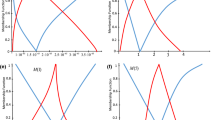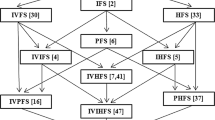Abstract
We introduce an evidential model for time-to-event prediction with censored data. In this model, uncertainty on event time is quantified by Gaussian random fuzzy numbers, a newly introduced family of random fuzzy subsets of the real line with associated belief functions, generalizing both Gaussian random variables and Gaussian possibility distributions. Our approach makes minimal assumptions about the underlying time-to-event distribution. The model is fit by minimizing a generalized negative log-likelihood function that accounts for both normal and censored data. Comparative experiments on two real-world datasets demonstrate the very good performance of our model as compared to the state-of-the-art.
Access this chapter
Tax calculation will be finalised at checkout
Purchases are for personal use only
Similar content being viewed by others
Notes
References
Cox, D.R.: Regression models and life-tables. J. Roy. Stat. Soc.: Ser. B (Methodol.) 34(2), 187–202 (1972)
Dempster, A.P.: Upper and lower probabilities induced by a multivalued mapping. Ann. Math. Stat. 38, 325–339 (1967)
Denœux, T.: Belief functions induced by random fuzzy sets: a general framework for representing uncertain and fuzzy evidence. Fuzzy Sets Syst. 424, 63–91 (2021)
Denœux, T.: An evidential neural network model for regression based on random fuzzy numbers. In: Le Hégarat-Mascle, S., Bloch, I., Aldea, E. (eds.) Belief Functions: Theory and Applications, pp. 57–66. Springer, Cham (2022). https://doi.org/10.1007/978-3-031-17801-6_6
Denœux, T.: Parametric families of continuous belief functions based on generalized gaussian random fuzzy numbers. Fuzzy Sets Syst. 471, 108679 (2023)
Denœux, T.: Quantifying prediction uncertainty in regression using random fuzzy sets: the ENNreg model. IEEE Trans. Fuzzy Syst. 31, 3690–3699 (2023)
Denœux, T.: Reasoning with fuzzy and uncertain evidence using epistemic random fuzzy sets: general framework and practical models. Fuzzy Sets Syst. 453, 1–36 (2023)
Faraggi, D., Simon, R.: A neural network model for survival data. Stat. Med. 14(1), 73–82 (1995)
Ishwaran, H., Kogalur, U.B., Blackstone, E.H., Lauer, M.S.: Random survival forests. Ann. Appl. Stat. 2(2), 841–860 (2008)
Katzman, J.L., Shaham, U., Cloninger, A., Bates, J., Jiang, T., Kluger, Y.: DeepSurv: personalized treatment recommender system using a cox proportional hazards deep neural network. BMC Med. Res. Methodol. 18(1), 1–12 (2018)
Kvamme, H., Borgan, Ø., Scheel, I.: Time-to-event prediction with neural networks and cox regression. J. Mach. Learn. Res. 20(129), 1–30 (2019)
Lee, C., Zame, W., Yoon, J., Van Der Schaar, M.: DeepHit: a deep learning approach to survival analysis with competing risks. In: Proceedings of the AAAI Conference on Artificial Intelligence, vol. 32 (2018)
Shafer, G.: A Mathematical Theory of Evidence, vol. 42. Princeton University Press (1976)
Acknowledgment
This research is supported by A*STAR, CISCO Systems (USA) Pte. Ltd, and National University of Singapore under its Cisco-NUS Accelerated Digital Economy Corporate Laboratory (Award I21001E0002) and the National Research Foundation Singapore under AI Singapore Programme (Award AISG-GC-2019-001-2B).
Author information
Authors and Affiliations
Corresponding author
Editor information
Editors and Affiliations
Rights and permissions
Copyright information
© 2024 The Author(s), under exclusive license to Springer Nature Switzerland AG
About this paper
Cite this paper
Huang, L., Xing, Y., Denœux, T., Feng, M. (2024). An Evidential Time-to-Event Prediction Model Based on Gaussian Random Fuzzy Numbers. In: Bi, Y., Jousselme, AL., Denoeux, T. (eds) Belief Functions: Theory and Applications. BELIEF 2024. Lecture Notes in Computer Science(), vol 14909. Springer, Cham. https://doi.org/10.1007/978-3-031-67977-3_6
Download citation
DOI: https://doi.org/10.1007/978-3-031-67977-3_6
Published:
Publisher Name: Springer, Cham
Print ISBN: 978-3-031-67976-6
Online ISBN: 978-3-031-67977-3
eBook Packages: Computer ScienceComputer Science (R0)




